
The Paris Commune was a revolutionary government that seized power in Paris, the capital of France, from 18 March to 28 May 1871.

The following is a timeline of the French Revolution.
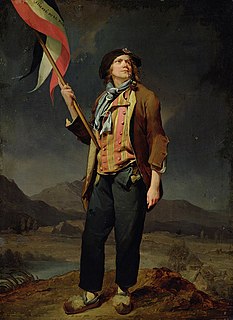
The sans-culottes were the common people of the lower classes in late 18th-century France, a great many of whom became radical and militant partisans of the French Revolution in response to their poor quality of life under the Ancien Régime. The word sans-culotte, which is opposed to that of the aristocrat, seems to have been used for the first time on 28 February 1791 by Jean-Bernard Gauthier de Murnan in a derogatory sense, speaking about a "sans-culottes army". The word came into vogue during the demonstration of 20 June 1792.
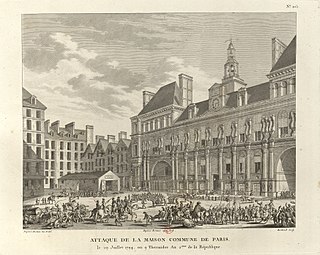
The Paris Commune during the French Revolution was the government of Paris from 1789 until 1795. Established in the Hôtel de Ville just after the storming of the Bastille, it consisted of 144 delegates elected by the 60 divisions of the city. Before its formal establishment, there had been much popular discontent on the streets of Paris over who represented the true Commune, and who had the right to rule the Parisian people. The first mayor was Jean Sylvain Bailly, a relatively moderate Feuillant who supported constitutional monarchy. He was succeeded in November 1791 by Pétion de Villeneuve after Bailly's unpopular use of the National Guard to disperse a riotous assembly in the Champ de Mars.

The National Guard is a French military, gendarmerie, and police reserve force, active in its current form since 2016 but originally founded in 1789 during the French Revolution.

Louis Charles Delescluze was a French revolutionary leader, journalist, and military commander of the Paris Commune.

Louise Michel was a teacher and important figure in the Paris Commune. Following her penal transportation to New Caledonia she embraced anarchism. When returning to France she emerged as an important French anarchist and went on speaking tours across Europe. The journalist Brian Doherty has called her the "French grande dame of anarchy." Her use of a black flag at a demonstration in Paris in March 1883 was also the earliest known of what would become known as the anarchy black flag.

The Mayor of Paris is the chief executive of Paris, the capital and largest city in France. The officeholder is responsible for the administration and management of the city, submits proposals and recommendations to the Council of Paris, is active in the enforcement of the city's ordinances, submits the city's annual budget and appoints city officers, department commissioners or directors, as well as members of city boards and commissions. During meetings of the Council of Paris, the mayor serves as the presiding officer, as it is the case in any other commune in France. Since Paris doubles as a department as well, the mayor also has the rank of a departmental council president.

The Government of National Defense was the first government of the Third Republic of France from 4 September 1870 to 13 February 1871 during the Franco-Prussian War. It was formed after the proclamation of the Republic in Paris on 4 September, which in turn followed the surrender and capture of Emperor Napoleon III by the Prussians at the Battle of Sedan. The government, headed by General Louis Jules Trochu, was under Prussian siege in Paris. Breakouts were attempted twice, but met with disaster and rising dissatisfaction of the public. In late January the government, having further enraged the population of Paris by crushing a revolutionary uprising, surrendered to the Prussians. Two weeks later, it was replaced by the new government of Adolphe Thiers, which soon passed a variety of financial laws in an attempt to pay reparations and thus oblige the Prussians to leave France, leading to the outbreak of revolutions in French cities, and the ultimate creation of the Paris Commune.
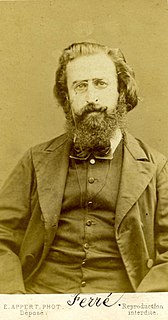
Théophile Charles Gilles Ferré was one of the members of the Paris Commune, who authorized the execution of Georges Darboy, the archbishop of Paris, and five other hostages, on 24 May 1871. He was captured by the army, tried by a military court, and was shot at Satory, an army camp southwest of Versailles. He was the first of twenty-five Commune members to be executed for their role in the Paris Commune.

The June Rebellion, or the Paris Uprising of 1832, was an anti-monarchist insurrection of Parisian republicans on 5 and 6 June 1832.

Émile François Désiré Eudes was a French revolutionary, Blanquist socialist and participant in the Paris Commune.
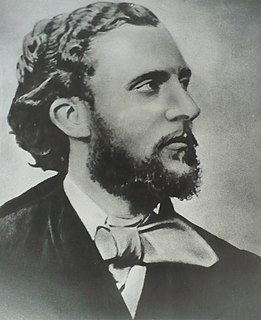
Walery Antoni Wróblewski was a French-Polish revolutionary, politician, general of Paris Commune and commander of January Uprising and one of the leaders of the Reds.
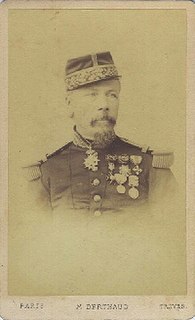
Claude Lecomte was a French general killed by the National Guard of the Paris Commune.

Jacques Léon Clément-Thomas, was born in 1809 in Libourne (Gironde) and shot in Paris on 18 March 1871, one of the first deaths of the Paris Commune. A Republican of the old guard, Clément-Thomas was an army general, Commander in Chief of France's National Guard on two occasions, and a parliamentary deputy.
This chronology of the Paris Commune lists major events that occurred during and surrounding the Paris Commune, a revolutionary government that controlled Paris between March and May 1871.

The Lyon Commune was a short-lived revolutionary movement in Lyon, France, in 1870 and 1871 - republicans and activists from several components of the far-left of the time seized power in Lyon and established an autonomous government. The commune organized elections, but dissolved after the restoration of a republican "normality", which frustrated the most radical elements, who hoped for a different revolution. Radicals twice tried to regain power, without success.
The Commune Council, simply known as the Commune, was the government during the 72-day Paris Commune in 1871. Following elections on 26 March, the municipal council adopted the formal name Paris Commune in its first session, implying a more revolutionary intent. The council declared itself and its name on 28 March at the Hôtel de Ville as a celebratory event. Their first proclamation followed the next day, reminding citizens of their autonomy and warning of civil war. The Commune was supported by the vast majority of Parisians. The Central Committee of the National Guard recognized and relinquished power to the Commune, but continued to organize as the "guardian of the revolution". The two groups exercised a de facto dual sovereignty.
On October 31, 1870, a popular insurrection occupied Paris's City Hall. Amidst the Franco-Prussian War, Parisians simultaneously heard of losses at Le Bourget and Metz alongside armstice negotiations. Incensed by what they viewed as treason, a group of 300 to 400 demonstrated at the City Hall and members of the left-wing National Guard captured and occupied the building with several members of the Government of National Defense inside.
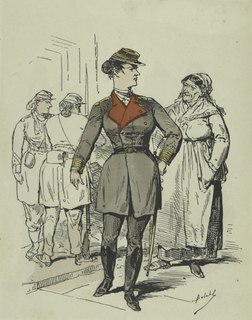
Adélaïde Valentin, also known as Colonel Valentin, was a labourer and communard. She was, during the last month of the Paris Commune, the colonel of the Federated Legion of Women.

















